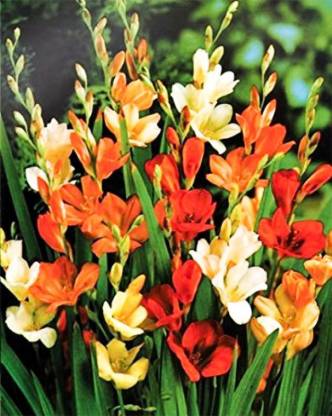Tritonia (fire freesia) suitable for a sunny place Suitable for semi-shade Flowering Period – July Onwards.
Tritonia presents as only a small bulb but doesn’t let size deceive you- it produces an amazingly gorgeous flower! Similar to Freesias, they have taller stems and naturalize more effectively; no fragrance means they are a good addition for allergy sufferers who find scented gardens difficult to cope with. They are a very tolerant plant and suit just about every climate. Mid-late season flowering.
Tritonia (fire freesia) is a variety of blooming plants in the iris family initially portrayed as a class in 1802. They are normally dispersed crosswise over southern Africa, with a high grouping of animal varieties in Cape Province of western South Africa. The family is firmly identified with the sort Ixia.
Tritonia are little bulbous plants up to 8 cm, that show up in extraordinary numbers in spring. The leaves are fan-molded. The blossoms are shades of yellow, orange or dark-colored, sweet-noticing, and radiate an extremely solid scent, particularly around evening time. They are not brushed.
The family name is gotten from the Latin word triton, signifying “Weathervane”, and implies the clearly arbitrary game plan of the stamens in a few animal varieties.
Common Names: Flame Freesia, Lined Tritonia, Blazing Star, Montbretia.
Life Cycle: Bulb commonly grown as an annual by gardeners.
Height: 4 to 24 inches (10 to 60 cm).
Native: Southern Africa.
Growing Region: Zones 3 to 10. As a perennial in zones 7 to 10.
Flowers: Spring and/or summer.
Flower Details: White, cream, yellow, brown, red, orange, pink. Funnel-shaped. Bowl-shaped. Fragrant.
Foliage: Fan-shaped. Sword-shaped.
Sow Outside: Separating 4 to 10 inches (10 to 30 cm).
Seed: cover seed. Pre-winter in warm zones; late-winter in mellow/cooler zones. Best developed from corms in chilly territories.
Corm: 4 inches (10 cm). Fall in warm regions. Spring in different zones.
Sow Inside: Germination time: one to two months. Temperature 55°F (13°C). Seven or two months ahead of time. Transplant outside half a month after the last ice or in harvest time in hotter territories.
Necessities: Full daylight. Great waste. Rich soil. Sandy soil. Natural soils. Blend in dairy animals compost. One feed. Customary watering in the developing season. Winter mulch. Bring globules inside for the winter in cooler regions. Engender counterbalances in pre-winter in warm zones or half a month after the last ice in different zones.
Various: The name for the class originates from the latin for the expression “Climate vane”.


